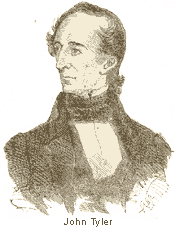Following the 16th century conquests of Hernando Cortez, Spanish forces extended their influence northward into what is the present-day United States. This Expansion established a Spanish (and later Mexican) claim to much of the southwestern part of the United States and California. Increasing numbers of American settlers filled the region north of the Rio Grande, particularly in the 1820s and 1830s. This resulted in a successful drive for Texas Independence and a push for annexation that soon after the United States recognized the Texas Republic on March 3, 1837. The idea of annexing Texas was popular in the South, but widely opposed in the North. Not only would Texas represent another slave state, but the nature of Texas society did not appeal to cultivated New Englanders. William Ellery Channing, pastor of the Federal Street Church in Boston, wrote to Henry Clay on the issue in August 1837:
Having unfolded the argument against the annexation of Texas from the criminality of the revolt, I proceed to a second very solemn consideration, namely, that by this act our country will enter on a career of encroachment, war, and crime, and will merit and incur the punishment and woe of aggravated wrongdoing. The seizure of Texas will not stand alone. It will darken our future history. It will be linked by an iron necessity to long continued deeds of rapine and blood. Ages may not see the catastrophe of the tragedy, the first scene of which we are so ready to enact. It is strange that nations should be so much more rash than individuals; and this, in the face of experience which has been teaching from the beginning of society, that, of all precipitate and criminal deeds, those perpetrated by nations are the most fruitful of misery.
 President Tyler attempted to bring about annexation in 1844 as a matter of national policy, but when a communique from John C. Calhoun, the secretary of state, to the British envoy in Washington, stating that annexation was necessary for the preservation of Slavery in America, was published in April, sectional controversy arose.
A treaty to annex Texas was submitted to the Senate on April 22, 1844. In opposition, Rep. Joshua Giddings, an Ohio Whig, denounced the prospect in a speech to the House on May 21, 1844. After pointing out the benefits of the balance of power being held by the North and West, he went on:
President Tyler attempted to bring about annexation in 1844 as a matter of national policy, but when a communique from John C. Calhoun, the secretary of state, to the British envoy in Washington, stating that annexation was necessary for the preservation of Slavery in America, was published in April, sectional controversy arose.
A treaty to annex Texas was submitted to the Senate on April 22, 1844. In opposition, Rep. Joshua Giddings, an Ohio Whig, denounced the prospect in a speech to the House on May 21, 1844. After pointing out the benefits of the balance of power being held by the North and West, he went on:
But let us admit Texas, and we shall place the balance of power in the hands of the Texans themselves. They, with the Southern states, will control the policy and the destiny of this nation; our tariff will then be held at the will of the Texan advocates of free trade. Are our friends of the North prepared to deliver over this great national policy to the people of Texas?The question of admitting Texas to the Union loomed large in the Election of 1844. Forces favoring admission included pro-slavery Southerners and people of all political stripes who feared (with some reason) that Britain was considering an active role in Texas. Opposing annexation were Northerners who objected to the spread of slavery on either moral or economic grounds, and those who predicted that admitting Texas would lead to war with Mexico. President John Tyler waited until three days before leaving office to sign a joint resolution providing for the annexation of Texas, sparing his successor, James K. Polk, from making that momentous decision but saddling him with the prospect of war with Mexico. Despite peace attempts, the Mexican War began in 1846. While the war was in progress the Wilmot Proviso was advanced in an effort to stop the spread of slavery.